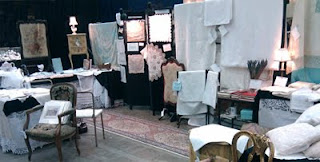We'll have the regular fare, our signature flax wheel, linen damasks big and small and some as old as the late 1700s. I'm taking two magnificent white linen lawn, hand embroidered and tucked baby comforters I bought from England. Well, duvets actually. I've replaced the old insides with new down comforters from Warm Things. Oodles of Madeira hand embroidery and some top of the line Marghab. Already packed are books on textiles and fox hunting books and paraphernalia. The vintage books are all limited editions numbered and are from the collection of (James Orthwein Anheuser-Busch family, Master of Hounds and former NFL Patriots owner) and are signed to him by the author, Alexander MacKay-Smith. My fave is The Songs of Foxhunting
Also my faves, I'm caring Engleside products Restoration Linen Wash, Quilt Wash and Cotton Wash. There'll be a future post on caring for linens, but, for now, the answer is Restoration.
I'll be mangling, starching and ironing late into the night. Even in this heat, rooms full of lavender scented steam are my nirvana. . This from a woman who tells her husband ironing shirts is what God made dry cleaners for. Oh, well. I've been told by the best that unless you're sewing in the car, you're not doing a linen show right, so I'm fight on track.
The books and fox hunting paraphernalia (and lace, of course).
And some of Spring's Charleston Show
Hope we see you all there. Mention this blog, and get a whopping 20 percent off anything and everything.











